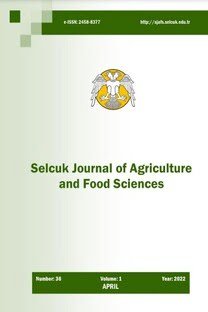PLC kontrollü PV-batarya-solar sulama pompa sisteminin performansının yükseltilmesi
sulama donanımı, otomatik kontrol, Türkiye, pompalar
Increasing the performance of plc controlled PV-battery-solar irrigation pump system
irrigation equipment, automatic control, Turkey, pumps,
___
- Acaroğlu, M., Alternative Energy Sources, Book (in Turkish), 2003, Atlas Pres, İstanbul.
- Al-Mohamad, A., Efficiency improvements of photo- voltaic panels using a Sun-tracking system, Ap- plied Energy 79 (2004) 345–354
- Altaş, İ.H., Fotovoltaj Güneş Pilleri yapısal Özellikleri ve Karakteristikleri. 3e dergisi Nisan 1998, sayı 47 sayfa 66-71
- Anis,W.R.,Metwally,HMB.Dynamic performance of a directly coupled PV pumping system, Solar Ener- gy 1994; 53(4): 369–77
- Badescu, V., Dynamic Model Of A Complex System Including PV Cells, Electric Battery, Electrical Motor And Water Pump, Energy 28 (2003) 1165– 1181
- Benlarbi, K., Mokrani, L., Nait-Said, M.S., A Fuzzy Global Efficiency Optimization Of A Photovoltaic Water Pumping System, Energy 77 (2004) 203– 216
- Çelik, A., Abut, N., Dynamic model of complex sys- tems with PV, battery, electrical motor and water pump, Engineering Sciences Young Researchers Congress, MBGAK 2005 Istanbul 17–19 No- vember 2005
- Çelik, A.N.”Present Status Of Photovoltaic Energy İn Turkey And Life Cycle Techno-Economic Analy- sis Of A Grid-Connected Photovoltaic-House” Re- newable and Sustainable Energy Reviews 10 (2006) 370–387
- Çolak, M, 1992. Photovoltaic (PV) and Applications, E.Ü. Solar Energy Institute, Textbook, (in Turkish - unpublished). Izmir, Turkey
- Yeşilata, B., Firatoğlu, Z., A.,““Investigation of opera- tion characteristics for battery-buffered and direct- ly-coupled PV pumping systems”, Renewable Energy Symposium, Paper 129-136, 10-12 Sep- tember, 2001, Kayseri .
- Fıratoğlu, Z., A.,Yeşilata, B., “Optimization of PV Panels Coupled with a Linear Electrical Load and Investigation of its Regional Utililization, 4. GAP Engineering Congress, Paper 204-212, 06-08 June, 2002, Sanlıurfa
- Fıratoğlu, Z.A., Yeşilata, B., “Investigation of Opti- mum Design and Operation Conditions for Photo- voltaic Systems with MPPT”, Dokuz Eylul Uni- versity, Science and Engineering J. 1, 13/1–13/10, 2003, (in Turkish)
- Fıratoğlu, Z.A., Yeşilata, B., Multı-Step Optımızatıon Of The Dırectly-Coupled Pv Pumpıng Systems,, Journal of Engineering and Natural Sciences, Sig- ma 2005/1, (53-67)
- Gençoğlu,M.T, Güneş Enerjisi İle Çalışan Su Pompa- lama Sistemleri 3 E Dergisi Sayı 138, Kasım 2005
- Ghoneim, A.A., Design Optimization of Photovoltaic Powered Water Pumping Systems, Energy Con- version and Management, 47 (2006) 1449–1463
- Grundfos, Solar Pump user Guides, 2005 Hadj Arab A, Chenlo F, Mukadam K, Balenzategui, J,L “Performance of PV water pumping systems”, Renewable Energy, Volume 18, Issue 2, October 1999, Pages 191-204
- http://re.jrc.ec.europe.eu/pvgis , European Communi- ties, 2006, (10. June. 2007)
- http://www.siemens.com ,SIMATIC S7 200 Pro- grammable Logic Controllers Using Guide 2003 Siemens, (15. May. 2007)
- http://www.Yuasa.tr.com , Yuasa Characteristic of Batteries, (18. April. 2007)
- Khouzam, KY. The load matching approach to sizing photovoltaic systems with short-term energy sto- rage, Solar Energy 1994; 53(5):403–9
- Meah K, Ula, S, Barrett,S, “Solar Photovoltaic Water Pumping—Opportunities and Challenges” Renew- able and Sustainable Energy Reviews, (2006)
- Odeh,I , Yohanis, Y.G, Norton, B,”Influence Of Pumping Head, Insulation And PV Array Size On PV Water Pumping System Performance”, Solar Energy 80 (1), (2006) 51–64
- Protogeropoulos, C., Marshal, R.H., Brinkworth, B.G., Battery state of voltage modeling and an algorithm describing dynamic conditions for long-term sto- rage simulation in a renewable system, Solar Energy 1994; 53(6):517–27.
- Salah, A., Salem, N., Two Axes Sun Tracking System with PLC Control, Energy Conversion and Man- agement 45 (2004) 1931–1939
- Sunset Enerji, http://www.sunsetenerji.com.tr Tekno- lojik bilgiler ve kullanım kılavuzları. Çağlayan Mah. 2032.Sk. Ünal Apt 1. Blok D.1Lara ANTALYA /TÜRKİYE
- Zaki, A.M.N, “Matching of photovoltaic motor pump systems for maximum efficiency operation”, Re- newable Energy, Vol. 7 pp. 279-288.1996.
- ISSN: 1300-5774
- Yayın Aralığı: 3
- Başlangıç: 2018
- Yayıncı: Selçuk Üniv. Ziraat Fak.
NURDİLEK GÜLMEZOĞLU, Emel ÖZER, SEYFİ TANER, Engin KlNACI
İlknur Kutlar YAYLALI, NİZAMETTİN ÇİFTÇİ
Yenidünya (Eriobotrya japonica Lindl.) yapraklarında karbonhidratlar ve azotun mevsimsel değişimi
Düşük tenörlü fosfat kayalarının basit nitrolanması ile gübre üretilebilirliği üzerine bir araştırma
Haydar POLAT, Mehmet ÇÖTELİ, İrfan GENCER
AYSUN ÇAVUŞOĞLU, Abdülkadir Akçın
İdris BAHÇECİ, ALİ FUAT TARI, Nazmi DİNÇ
Süt sığırcılığında sosyal gruplu açık sistem mikro yapı tasarımı
Gelişen incir (Ficus carica L. Bursa Siyahı) meyvelerinin içsel zeatin düzeylerindeki değişimler
